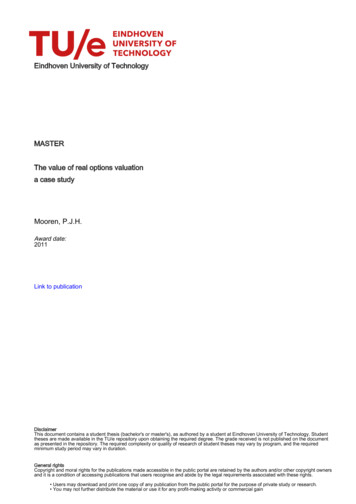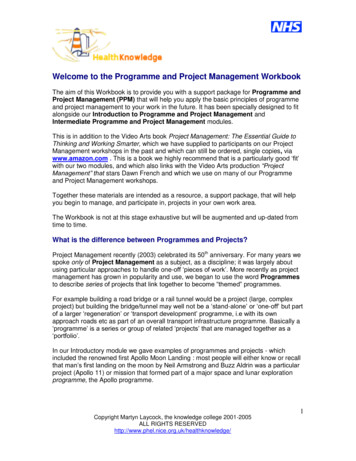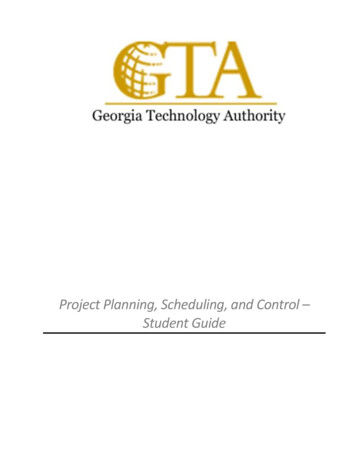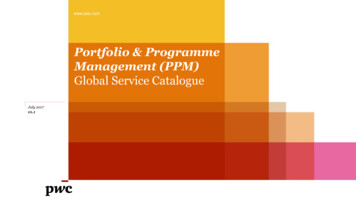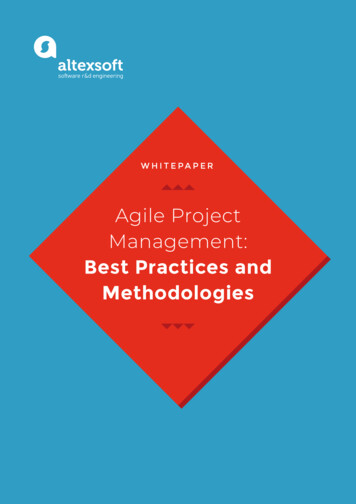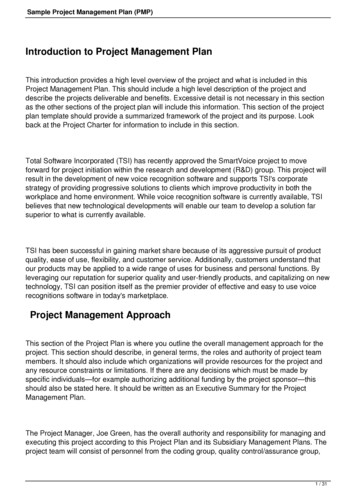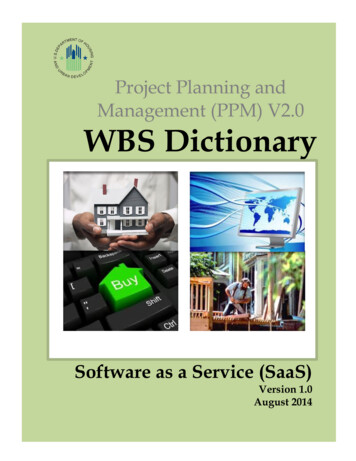
Transcription
Project Planning andManagement (PPM) V2.0WBS DictionarySoftware as a Service (SaaS)Version 1.0August 20141
Table of ContentsPPM V2.0 Work Breakdown Structure (WBS) DictionaryProject Type: Software as a Service (SaaS) (WBS Level 1)Pre-PPM Activities111Establish Project Sponsor1Determine IT Project Manager1Conduct Program/Project Management2Milestone: Project Approved2Initiation Phase2Complete Project Initiation Form (PIF)2Milestone: Project Commencement Notification Completed2Establish Integrated Project Team (IPT)3Conduct Project Kickoff Meeting3Develop Project Charter3Milestone: Project Charter Completed3Develop Initial Detailed Work Breakdown Structure for Project Type4Develop Initial Detailed Project Schedule (Minimum through Planning Phase)4Update/Validate Business Case and Life Cycle Cost Estimate (from budget formulationprocess)4Update/Validate Projected Project or Solution Benefits (from budget formulation process) 4Assess Preliminary Procurement Support Needed5Develop Procurement Management Approach and Plan (if applicable)5Finalize Artifacts and Obtain Necessary Signoffs/Signatures5Milestone: Procurement/Acquisition Approach Defined5Conduct Project Validation Review Control Gate5Conduct Program/Project Management6Milestone: Project Initiated6Planning Phase6Procure Resources per the Acquisition Strategy (for Requirements or Entire Project)6Milestone: Contracts Signed/ Task Order Issued (Planning Phase Support)7Develop Project Tailoring Agreement (PTA)7Mobilize Resources (People)7Re-Evaluate Project Timeline and Update Project Schedule7Develop Project Management Approach and Plan7Develop the Concept of Operations (CONOPS) (at the Initiative or Program Level)8Identify Project Business and Functional Requirements8Milestone: Project Requirements Defined8Develop Solution Architecture8August 19, 2014i
Milestone: Solution Architecture Completed9Develop Risk Management Plan and Risk Log9Develop Quality Assurance Approach and Plan9Develop Communications Management Plan9Determine Project Approach for Independent Verification and Validation (IV&V)10Develop Security and Privacy Documentation10Update Project Schedule from Initiation Phase10Finalize Artifacts and Obtain Necessary Signoffs/Signatures10Conduct Project Baseline Review Control Gate10Conduct Program/Project Management10Conduct IV&V Activities11Milestone: Project Planning Completed11Execution & Control Phase11Procure Resources per the Acquisition ment and/or Solution (if applicable)11Determine Service Level Expectations12Monitor and Control Quality Assurance Activities12Develop Solution Technical Design and Define Interfaces12Milestone: Solution Technical Design Completed12Execute Change Management Process13Plan the Implementation and Release Approach13Determine SaaS Testing Strategy13Create the Data Conversion Strategy (if applicable)14Test Configuration and Approve SaaS Solution14Conduct User Acceptance Testing (UAT) (if applicable)14Milestone: Validation/Configuration and Testing Completed14Develop Training Strategy and Plan15Develop End User Training Content15Conduct Training for End Users16Create Operations and Maintenance Documentation (User)16Create and/or Update Security Artifacts16Obtain Authorization to Operate (ATO)16Install the Solution / Submit the Software Release Request (HARTS)16Milestone: Production Environment Ready17Conduct Project Operational Readiness Review Control Gate (Repeat as Necessary)17Authorize SaaS Provider to Release Solution in Production for Official Go-Live17Conduct Program/Project Management17Conduct IV&V Activities17August 19, 2014ii
Milestone: Go-Live/Solution in Production for End Users/Customer BaseClose Out Phase1818Conduct Post Deployment/Warranty Support (if applicable)18Conduct Post-Deployment Review18Conduct Project Close Out Activities19Prepare Project Completion Report19Conduct Project Close Out Review Control Gate19Milestone: Project Close Out Completed20Provide System Documentation to HUD IT Operations20Conduct Program/Project Management20Conduct IV&V Activities20Milestone: Project Finished20IndexAugust 19, 201421iii
PPM V2.0 Work Breakdown Structure (WBS) DictionaryProject Type: Software as a Service (SaaS) (WBS Level 1)A WBS Dictionary contains more detailed information about elements within a Work Breakdown Structure (WBS). The tool can be as detailed as the IT ProjectManager wants it to be to help manage the project. The WBS is a useful resource for project management and should be consulted for relevant information oneach component of the WBS. Included in the WBS description can be: a brief definition of the WBS element (function, deliverable, etc.) associated activities,milestones, and other information such as performance measurement criteria, statement of work paragraph number, contract line item, start and end dates,resource requirements, cost estimates, quality requirements, technical content, contact information, and revision history.Below is a WBS Dictionary mapped to the Software-as-a-Service (SaaS) PPM Project Type Guide that contains definitions of each WBS element. The IT ProjectManager can then augment the information with the specifics of his or her project. Users should reference the Software as a Service Project Type Guide and thePPM V2.0 phase-specific user guides for additional information and detail.NOTE: This WBS Dictionary is just a supporting document, which provides the definitions for each component contained in the Work BreakdownStructure, and serves as a guide.ReferenceID:WBS Element Name:1.11.1.11.1.2August 19, 2014WBS Description:Pre-PPM ActivitiesThis summary task covers all pre-PPM activities prior to a project commencing the PPM life cycle.Activities in this area basically cover the selection of both the Project Sponsor and IT Project Manager.These resources are necessary to begin project initiation activities.Establish Project SponsorThis activity covers the determination of the Project Sponsor. Key responsibilities of the ProjectSponsor include: Providing clear direction for the project and how it links with the organization’soverall strategy; securing project resources; ensuring the project is on time, on budget, and on scope;and championing the project at the executive-level to secure buy-in.Determine IT Project ManagerThe IT Project Manager (IT PM) is selected by the Office of Customer Relationship and PerformanceManagement (OCRPM)-Enterprise Program Management Division (EPMD) leadership. As the leader ofthe project team, the IT PM is responsible for managing tasks, schedules, resource assignments, andfor getting artifacts completed by subject matter experts. The IT PM oversees the day‐to‐dayexecution of the project, facilitates resolution of issues, and reports status at regular intervals.1
ReferenceID:WBS Element Name:WBS Description:1.1.3Conduct Program/Project ManagementThis activity occurs within all major phases of the project life cycle and documents all program andproject management-related tasks. It includes the effort spent planning, organizing, and controllingthe aspects of the project including updating project status, maintaining the project schedule, andcoordinating meetings among team members.1.1.4Milestone: Project ApprovedThis milestone task denotes that pre-PPM activities have been completed and through completionof those tasks, means that the project is officially approved. This milestone is common across allproject types to facilitate reporting.1.21.2.11.2.2August 19, 2014Initiation PhaseThis summary task covers all activities within the Initiation Phase of the project.Complete Project Initiation Form (PIF)In PPM V2.0, the first step in the Initiation Phase is the completion and submission of a new ProjectInitiation Form (PIF) which replaces the Work Request Form (WRF) from PPM V1.0. Projects only haveone control gate in the new PPM V2.0 Initiation Phase (this phase aligns with PMBOK). The IT PMcompletes the PIF for the project. The two major objectives of this document are to:1) Notify key Office of the Chief Information Officer (OCIO) stakeholders that a project (whether it wasapproved via the normal budgeting process or outside the normal budgeting process) is starting.2) Request OCIO IPT members - All projects may not require OCIO IPT members based on thecharacteristics of the project. For example, if HUD is leveraging a shared service line of business, thenthe need for OCIO IPT members is reduced.Milestone: Project CommencementNotification CompletedThis milestone denotes completion of the actual submission by the IT PM of the PIF and the receiptof the signatures of the TRC Chair, Customer Relationship Coordinator (CRC), and Business Lead. TheCRC then distributes the PIF to the pre-determined point-of-contact within the OCRPM-EPMD,OCRPM-Investment Management Division, OCRPM-Enterprise Architecture Division, and OCIO-ITOperations. In addition, IPT OCIO members are determined by each discipline based on the requestand notification of team member assignments will be sent to the IT PM.2
ReferenceID:WBS Element Name:WBS Description:Establish Integrated Project Team (IPT)In this activity, an IPT is assembled to complete the remaining tasks throughout the PPM life cycle.The IPT also monitors project developments and creates necessary documentation throughout therest of the project’s life cycle. The IT PM and Business Lead, in conjunction with the CRC and OCRPMEPMD Program Management Office (PMO), determine which subject matter experts (SMEs) from theprogram areas can contribute to the successful development of the project and should be included inthe IPT. The IT PM, Business Lead, and Project Sponsor are required members of the IPT. Other keypersonnel needed on the IPT vary from project to project. The IT PM, Business Lead, and the selectedIPT must ensure that people with the right skill sets are participating to ensure that the correctinformation is considered when making project type selection and artifact requirement decisions andcomplete all activities throughout the PPM life cycle. Both business and technology SMEs shall makeup the IPT. The IPT works as a team of decision makers to achieve consensus on tasks related toguiding a project through the PPM life cycle. The IPT ensures that all stakeholders are involved duringall of the phases of the PPM life cycle, and that significant concerns are directed towards theappropriate governance board.Conduct Project Kickoff MeetingAfter establishment of the IPT (1.2.3), the IT PM should schedule and conduct a formal project kickoffmeeting. The project kickoff meeting represents the first meeting with the project team whichincludes the customer/program area, OCIO team members, and other subject matter experts. Thismeeting introduces the members of the project team and provides the opportunity to discuss the roleof each team member. Other components of the project may also be discussed at this meeting(project schedule, status reporting, etc.).1.2.5Develop Project CharterThe Project Charter identifies an opportunity for improving a business or technology function byhighlighting where strategic goals are not being met or where performance can be improved, anddemonstrates a proposed project’s worth and its potential impacts on systems, staff, and operations.The IT PM and Business Lead primarily author the Project Charter to the best of their ability at thispoint of the project. The Project Sponsor is a required signoff on this document.1.2.6Milestone: Project Charter Completed1.2.31.2.4August 19, 2014This milestone task denotes that a key artifact, the Project Charter, has been completed. This isconsidered a key milestone and is common across all project types to facilitate reporting.3
ReferenceID:WBS Element Name:WBS Description:1.2.7Develop Initial Detailed Work BreakdownStructure for Project TypePPM V2.0 introduces new functionality around a Work Breakdown Structure (WBS) to help define thescope baseline, per recommendations made by GAO. In PPM V2.0, a sample WBS is provided for eachproject type down to level three. This format should give the IT PM and Business Lead a thoroughlisting of key activities to be performed for the specific project type. In addition, the WBS to levelthree is built into the Project Schedule template. As project management matures at HUD, aconsistent approach to project planning by project type will provide HUD the ability to benchmarkproject costs and performance by project type.1.2.8Develop Initial Detailed Project Schedule(Minimum through Planning Phase)The IT PM and Business Lead with assistance from members of the IPT develops a Project Schedulethat defines the tasks from project inception through the Planning Phase at the level of detailnecessary to support successful implementation. For the duration of the project, high-level projectmilestones and dates are provided with more detail to be included as the project continues.Update/Validate Business Case and LifeCycle Cost Estimate (from budgetformulation process)This activity serves as the link between investment planning activities and PPM for a specific project.In this activity, the IT PM and Business Lead reference the information previously submitted forbudget formulation and/or expenditure plan documentation, and updates the information andassumptions as appropriate since most often there is a long duration from the appropriationsdecisions to project initiation. Updates include business case information and estimated quantitativebenefits as well as the high-level life cycle cost estimate. If there is a 10% or greater variance, then theproject team must meet with the Director of the OCRPM-Investment Management Division todetermine next steps. If the information is consistent, then the project team updates as appropriateand submits updated information at the Project Validation Review.Update/Validate Projected Project orSolution Benefits (from budgetformulation process)Similar to 1.2.9, this activity serves as a link between investment planning activities and PPM for aspecific project. In this activity, the IT PM and Business Lead reference the information previouslysubmitted for budget formulation and /or expenditure plan documentation, and updates the benefitsinformation and assumptions as appropriate since most often there is a long duration from theappropriations decisions to project initiation. A change in benefit projections should be brought to theattention of the TRC at the Project Validation Review.1.2.91.2.10August 19, 20144
ReferenceID:1.2.11WBS Element Name:Assess Preliminary Procurement SupportNeededWBS Description:In this activity, the IPT determines if any preliminary procurement support will be needed on theproject. This support would most likely cover the Planning Phase activities and tasks. If it is required,the IPT should initiate any procurement/acquisition process due to typical lead times involved withbringing contractor support onboard. This activity would also be documented in the ProcurementManagement Plan.1.2.12Develop Procurement ManagementApproach and Plan (if applicable)The Procurement Management Plan addresses the project’s strategy for managing acquisitions. Thecontent serves as the roadmap for effectively planning and managing acquisitions and shoulddocument the types of contracts to be used, address contract risks, determine dates for deliverables,and coordinate with other processes, such as scheduling and performance reporting. Additionally,early identification of metrics to be used in managing and evaluating contractors helps to ensure thatbusiness needs are addressed through contract support. The Procurement Management Plandocuments the project team’s planned approach prior to engagement with HUD’s Office of the ChiefProcurement Officer (OCPO). OCPO will assist the project with developing an Acquisition Plan for theactual acquisition itself (if needed). The investment-level Acquisition Strategy, part of the annual OMB300 business case process, should be in alignment with the Procurement Management Plan andacquisition-specific Acquisition Plan(s). A Procurement Management Plan is required for projects thatconsist of more than one contract. If only one contract is being used for a project, the project teamcan complete the Procurement Management component of the Project Management Plan in lieu of astandalone Procurement Management Plan.1.2.13Finalize Artifacts and Obtain NecessarySignoffs/SignaturesDuring this activity, the IT PM should also ensure all deliverables are final, signed, and reviewed by theproper team members prior to submission. Signatures needed by artifact are depicted in the SignatureAuthority Matrix on the PPM website.1.2.14Milestone: Procurement/AcquisitionApproach DefinedThis milestone task denotes that a key activity, the determination of a procurement/acquisitionapproach has been defined via in most cases the Procurement Management Plan. This is considereda key milestone and is common across all project types to facilitate reporting.Conduct Project Validation Review ControlGateIn order to pass through the Initiation Phase to the Planning Phase, a project team needs to receiveapproval from the TRC through a control gate. During this activity, the IT PM schedules a Control Gatereview meeting using the TRC’s scheduling process. The lead time on this effort is approximately twoweeks which should be built into the project schedule lead times. The two weeks provides the TRCmembers the chance to review the work completed and prepare comments prior of the meeting.1.2.15August 19, 20145
ReferenceID:WBS Element Name:1.2.16Conduct Program/Project Management1.2.17Milestone: Project Initiated1.31.3.1August 19, 2014WBS Description:This activity occurs within all major phases of the project life cycle and documents all program andproject management-related tasks. It includes the effort spent planning, organizing, and controllingthe aspects of the project including updating project status, maintaining the project schedule, andcoordinating meetings among team members.This milestone task denotes the completion of all major tasks and activities within the InitiationPhase and that a project has formally been initiated. This is considered a key milestone and iscommon across all project types to facilitate reporting.Planning PhaseThis summary task covers all Planning Phase activities for a project. In this phase, the integratedproject team (IPT) decides whether to modify and/or enhance an existing system, custom develop anew solution, install and configure a commercial or government off-the-shelf capability, or utilize aservice provided by an external commercial or government entity to meet the identified businessneeds. The team may also procure resources per the Acquisition Strategy or ProcurementManagement Plan for the requirements activities or Planning Phase activities only. It may also procuresupport for the entire project life cycle through deployment.During the Planning Phase, the IPT develops a Concept of Operations (CONOPs) and then gathers anddocuments detailed business and functional requirements supporting it. The team also develops adetailed Project Schedule for the project. A high-level Solution Architecture document is created andapproved and other relevant project management planning activities are documented. The projectbaseline is established and approved at the Planning Phase control gate review, called the ProjectBaseline Review.Procure Resources per the AcquisitionStrategy (for Requirements or EntireProject)Methods of procurement of resources for this phase or the entire project may vary by project typeand should be outlined in the Acquisition Strategy (for major systems/programs) and the ProcurementManagement Plan. The Procurement Management Plan completed in the Initiation Phase describeshow a project team will acquire goods and services from outside of HUD. This activity includespreparing the Request for Contract Services (RCS) package for work that is to be completed. Ifcontract resources are to be used in the Planning Phase, the RCS package is completed prior to anyfurther progress in the Planning Phase. The RCS package is then circulated for review and approvalsignatures. Contractor proposals are solicited, reviewed, negotiated, and approved following steps infederal contracting guidelines.6
ReferenceID:1.3.21.3.3WBS Element Name:Milestone: Contracts Signed/ Task OrderIssued (Planning Phase Support)This milestone task denotes that all procurement activities necessary for contractor support for thePlanning Phase is completed. This is considered a key milestone and is common across all projecttypes to facilitate reporting.PPM V2.0 introduces five project types. At this point, since consideration of alternatives was doneboth in pre-PPM activities as part of budget formulation and during the Initiation Phase, the IPTshould be confident on the specific project type that will be followed. In this task, the IT PM accessesDevelop Project Tailoring Agreement (PTA) the PTA for the project type selected via the PPM V2.0 website and reviews and tailors it inconjunction with the Business Lead and IPT members. This document needs to be reviewed andapproved by the TRC Chair as early as possible in the Planning Phase (separate from the control gatereview) to ensure expectations and assumptions are in alignment.1.3.41.3.5WBS Description:Mobilize Resources (People)In this task, the IPT and contractor team (if applicable) is formally assembled to begin the formalproject planning activities that follow for the Planning Phase.Re-Evaluate Project Timeline and UpdateProject ScheduleDue to the fact that initial project timeline estimates were provided in many cases more than twelvemonths prior to the start of the project, many dates and assumptions are no longer valid. ThePlanning Phase is where a more confident project cost and schedule baseline should be established. Inthis activity, and since in most cases contractor support for the requirements gathering activities islikely on board, the joint team should re-evaluate the project timeline and update the ProjectSchedule accordingly. The IT Project Manager (IT PM) will need to work with his/her touch-point inthe Capital Planning and Investment Control (CPIC) function to determine HUD-required re-baselinetasks to follow should substantial changes occur.Develop Project Management Approachand PlanThe IT PM along with the Business Lead will have the responsibility of determining the projectmanagement approach which is documented in the Project Management Plan (PMP). A PMP defines,among other things, how the project is to be executed and controlled. GAO has reported thatagencies need to develop comprehensive project management plans, and leading practices emphasizethe importance of having a plan in place that, among other things, establishes a complete descriptionthat ties together all activities and evolves over time to continuously reflect the current status anddesired end point of the project. To be effective, a PMP integrates cost and schedule baselines fromplanning activities and consolidates subsidiary management plans.1.3.6August 19, 20147
ReferenceID:WBS Element Name:WBS Description:Develop the Concept of Operations(CONOPS) (at the Initiative or ProgramLevel)A Concept of Operations (CONOPS) depicts high-level requirements that provide a mechanism forusers to describe their expectations of the solution. The CONOPS is used as an input to thedevelopment of formal testable system and software requirements specifications. A CONOPS providesthe most value when depicting the integrated solution. So, if a program area is implementing a largesystem via a program which contains multiple projects within it, it would be expected that theCONOPS be produced at that program level to show how the entire system and its parts wouldoperate.1.3.8Identify Project Business and FunctionalRequirementsIn this activity, the project’s detailed business and initial functional and technical requirements arecreated and reviewed. The Requirements Lead, in conjunction with the Business Lead, IT PM, and anyadditional IPT members, determines the project’s business, functional and non-functionalrequirements. The participants use the information in the issued task orders, statement(s) of work,and the approved Project Charter to assist in identifying the requirements. They also will use end userrequirements gathering sessions as an input channel as well as the CONOPs information. In addition,the Requirements Management Plan is used to document the information necessary for effectivelymanaging project requirements from definition to delivery. The IT PM and Business Lead assist theRequirements Lead who uses the business, functional, and non-functional requirements to create andupdate the requirements artifacts (Requirements Definition document and Requirements TraceabilityMatrix).1.3.9Milestone: Project Requirements DefinedThis milestone task denotes that a key activity, the development of detailed project requirements,has been completed. This is considered a key milestone and is common across all project types tofacilitate reporting.Develop Solution ArchitectureHUD applications must be in alignment with HUD’s Enterprise Architecture. In this activity, theSolution Architecture will depict the initial and future relationship between the current solution andHUD’s architecture. The resulting output ensures that the Solution Architecture is in compliance withHUD enterprise architecture principles, best practices, and conceptual target applicationarchitectures. The target state includes business, enabling, and support services that are either reused from the current portfolio, leveraged from existing enterprise services, or established as newservices via projects to develop them. The Enterprise Architecture Lead, Lead Solution Architect, andIT PM will likely all determine how to develop and what to include in the Solution Architecture, as itultimately will be reviewed by the Chief Architect at the Planning Phase control gate review meeting.1.3.71.3.10August 19, 20148
ReferenceID:WBS Element Name:Milestone: Solution ArchitectureCompleted1.3.111.3.121.3.13WBS Description:This milestone task denotes that a key activity, the development of the Solution Architecture, hasbeen completed. This is considered a key milestone and is common across all project types tofacilitate reporting.Develop Risk Management Plan and RiskLogProject Risk Management includes the processes of conducting risk management planning,identification, analysis, response planning, and controlling risk on a project. In this activity, the IT PM,Business Lead, and Enterprise Architecture Lead describe at a high-level how the project will: conductrisk management activities, determine which risks may affect the project, prioritize risks for furtheranalysis or action, analyze the effect of identified risks on overall project objectives, develop optionsto reduce threats to project objectives, control risks, and complete the Risk Management Log.Develop Quality Assurance Approach andPlanThe purpose of this activity is to specify and document the quality assurance activities andresponsibilities for ensuring that the project meets the user requirements and conforms to HUD’sInformation Technology Management (ITM) Framework. In this activity, the IT PM defines theproject’s quality policies, procedures, areas of application, and associated criteria. He/she documentsthe quality management approach including the quality objectives and standards, methods and tools,and roles and responsibilities. The IT PM also describes the operational techniques and activities thatthe team will use to provide quality assurance, including identification of the assessments, reviews,and audits that will be conducted, the process for quality analysis, how quality will be determined andmeasured, and how corrective actions will be handled. The IT PM should consult with the BusinessLead, Testing Lead, and IPT when determining the quality assurance approach.Develop Communications ManagementPlanCommunications Management is how a project provides guidance and information on managingstakeholder expectations. The IT PM and Business Lead need to discuss how, when, and by whominformation about the project will be administered and disseminated and describe: stakeholdercommunications requirements, information to be communicated, reason for distribution ofinformation, person or groups who will receive information, escalation processes. They should alsodefine the processes and techniques the project will utilize to effectively engage stakeholders inproject decisions and execution based on the analysis of their needs, interests, and potential impacts.In addition, the IT PM and Business Lead should consult with the CRC, IPT, Project Sponsor, andprogram area stakeholders when developing the Communications Management Plan.1.3.14August 19, 20149
ReferenceID:WBS Element Name:WBS Description:1.3.15Determine Project Approach forIndependent Verification and Validation(IV&V)Validation answers the question, “Are we building the right product?” Verification answers thequestion, “Are we building the product right? Maintaining independence of the verification andvalidation processes is an essential element of the IV&V process. In this activity, the IT PM andBusiness Lead define the project approach for IV&V. IV&V partnerships provide high value to manyprojects and can be introduced at any phase of a project as determined by the project’s sponsorshipand/or governance requirements. Currently at HUD, IV&V guidance is being revised. When the newguidance is finalized, this content will be updated to reflect new requirements.1.3.16Develop Security and PrivacyDocumentationIn this activity, the project’s initial security and privacy measures are created, updated, reviewed, andapprove
Aug 19, 2015 · A WBS Dictionary contains more detailed information about elements within a Work Breakdown Structure (WBS). The tool can be as detailed as the IT Project Manager wants it to be to help manage the project. The WBS is a useful resource for project manag


